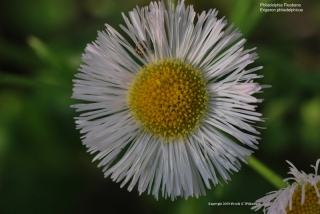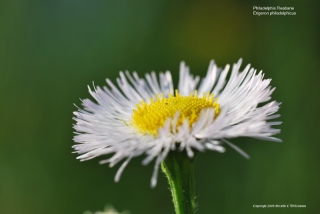If you’ll recall something I said in a previous article, you’ll be able to guess that the above flower is a member of the Aster family. Most folks have seen fleabane along roadsides and in fields. This small, daisy-like flower is very common, spread throughout Canada and the United States, including Alaska and Hawaii. This photo is of Philadelphia fleabane, Erigeron philadelphicus, growing on our lot in northwest Georgia.
When I first tried to put a name to one of these daisy-like flowers several years ago, I went to my copy of National Audubon Society Field Guide to North American Wildflowers–E: Eastern Region – Revised Edition and pretty quickly nailed it as a fleabane, the two fleabane species included in that book being the first flowers in the “White Daisy- and Dandelion-like” section of the photos. I called that one “Daisy Fleabane” – Erigeron annuus – at the time primarily because the photo showed E. annuus with white petals, and the other species listed, Philadelphia fleabane, had pink petals. The daisy fleabane identification may have been right in spite of the fact that both species have white to pink petals, because E. annuus is one of three species with widespread distribution throughout most of the United States, base on the USDA Plants Database:
- Daisy fleabane, Erigeron annuus, known in all but 7 states
- Prairie fleabane, Erigeron strigosus, known in all but 6 states
- Philadelphia fleabane, Erigeron philadelphicus, known in all but 4 states.
For those of us in the eastern part of the United States, it’s much easier to identify a specific fleabane species than for our western cohorts. The vast majority of the genus Erigeron’s 239 varieties of fleabane listed in the USDA Plants Database are primarily or exclusively west of the Mississippi. In addition to the three species listed above, there are only three or four more with distribution in parts of the eastern U.S.
For my recent identification of this flower found on my property, these three were the likely candidates, so I started my research to identify a unique characteristic that would tell me which of the three species it was. I checked my usual sources – the National Audubon book referenced above, IllinoisWildflowers.info, USDA Plants Database, my copy of Wildflowers of Tennessee by Jack Carman, and Nearctica.com.
The flowering characteristics seemed similar between the species, although E. philadephicus typically has more petals – actually ray flowers. As you can see by the photo at the beginning of this article, the central disk is composed of a large number of central disk flowers. The “petals” are actually ray flowers and may also produce seeds. This next photo shows the pistils of the central disk flowers sticking above the rest of the less mature flowers.
All three species have hairs on the stems and leaves, with E. annuus being the most hairy of them. But the key identification trait is the leaves. All three species have alternating leaves, but E. annuus‘ leaf narrows to a small petiole at the stem, E. strigosus‘ leaf has a distinct petiole, and the “winning characteristic” in the identification for me is that Philadelphia fleabane, Erigeron philadelphicus, has a leaf that clasps the stem. That characteristic, along with the relatively few hairs on the stem, can be seen in the photo below.
Visit the USWildflowers.com Photo Album Page for more nature photographs.
Disclaimer: I am not an expert on wildflowers. If you know of someone who disagrees with my identification, pay attention to them, do your own research, and encourage them to let me know where I might be incorrect. Thanks.



